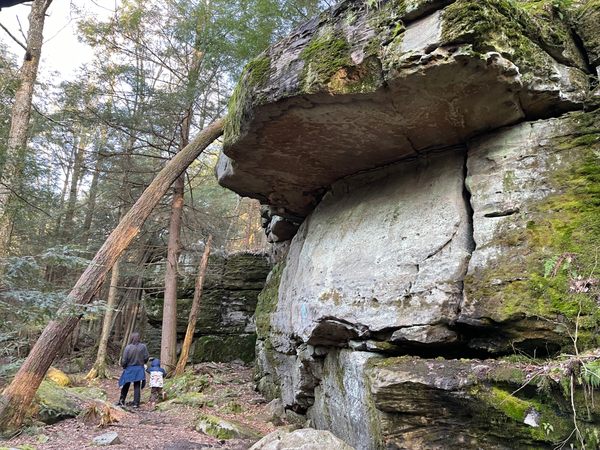A “rock city” consisting of large blocks weathering out of an outcrop is common in arid environments, and not only can be an aesthetically attractive feature but a recreational resource. Such features are not common in a humid environment like the Appalachians, however, where weathering is more extreme and heavy vegetation tends to smother bedrock outcrops.
A few such places do exist, however, and Bilger’s Rocks is one of the most spectacular. In fact, it’s been called the best example in Pennsylvania. Here blocks of crossbedded Homewood Sandstone of the Pottsville Formation, typically 20-25 feet thick, have broken out of the continuous strata in the bedrock.
Glacial freeze-thaw cycles let blocks settle into the soft substrate and slide apart at jointing (straight cracks), leading to gaps between the blocks ranging from inches to feet. Frost wedging (splitting by ice forming in cracks) no doubt also contributed to the erosion. Vegetation, tree roots in particular, has added to the wedging action and also the aesthetic appeal.
The appearance of large roots growing over the blocks has been likened to ruins in a lost city in the jungle. The larger cracks, wide enough to be passable to a person, also form hidden pathways that invite exploration.
Know Before You Go
One straightforward way is to take State Route 879 off Interstate 80 through Clearfield for 10.4 miles and turn right on the Greenville Pike. Then follow the Greenville Pike 2.3 miles to Bilger’s Rocks Road and turn left. Follow this road 0.7 mile; Bilger’s Rocks will be on the right.
Bilger’s Rocks is owned by a private non-profit corporation. There is no admission fee, but donations are requested.
On top, above the “rock city,” is the main parking area, as well as a playground and picnic area. However, the best access to the rock city is from below, where a trailhead is marked. To get there backtrack downhill along the road in, keeping on the left (facing downhill). Be careful of oncoming traffic.
Obviously, also be very careful with children and pets. Many of the cracks are wide enough, and deep enough, to cause serious injury, or even to be fatal in the event of a fall. The same also goes for the bluffs at the edge of the blocks.

